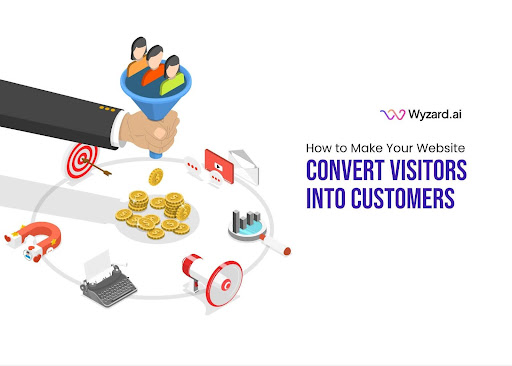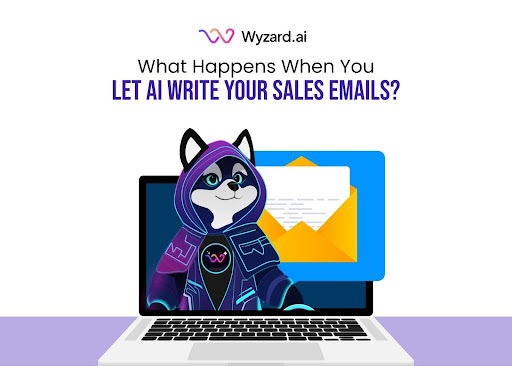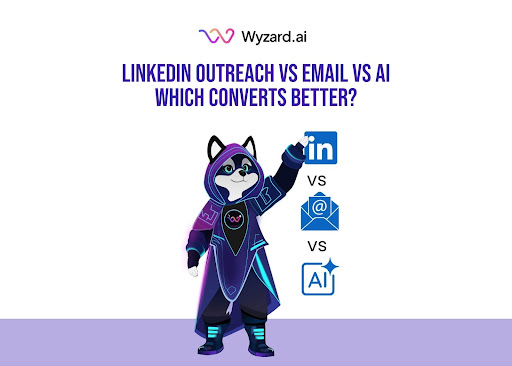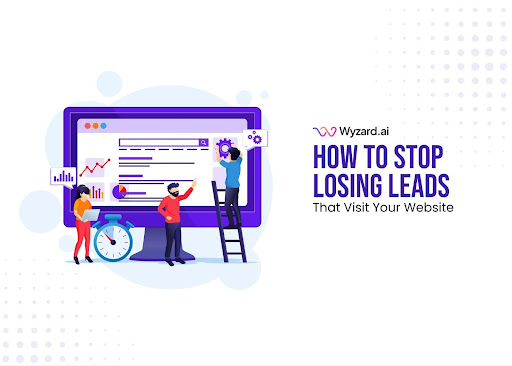Your sales team sends hundreds of emails weekly, but response rates keep dropping. You've heard about AI email writing ...

Subscribe Now
Getting traffic to your website is just the beginning. The real challenge lies in converting those visitors into paying customers. If you’re attracting hundreds or thousands of visitors monthly but seeing minimal conversions, you’re facing a common problem that many B2B SaaS companies encounter. The solution lies in implementing a strategic approach to website conversion optimization that transforms casual browsers into qualified leads and loyal customers.
Website conversion rate optimization isn’t just about making cosmetic changes to your site; it’s about creating a systematic approach that guides visitors through your conversion funnel while addressing their specific needs and concerns at each stage.
Understanding Website Conversion Strategy Fundamentals
Before diving into tactics, it’s essential to understand what drives visitor behavior. Your potential customers arrive on your website with specific intentions, questions, and pain points. A successful website conversion strategy addresses these elements systematically.
The foundation of any effective conversion approach starts with understanding your visitor’s journey. When someone lands on your site, they’re typically in one of three stages: awareness (researching solutions), consideration (evaluating options), or decision (ready to purchase). Your website needs to serve each of these audiences effectively.
Modern buyers expect immediate value and clear direction. They want to understand quickly how your solution addresses their challenges and why they should choose you over competitors. This expectation has made website conversion tips more crucial than ever for B2B SaaS companies looking to scale efficiently.
Essential Elements of Landing Page Optimization
Your landing pages serve as the front door to conversions. Landing page optimization focuses on creating focused, single-purpose pages that guide visitors toward specific actions. Unlike your homepage, which serves multiple audiences, landing pages should have one clear objective.
Effective landing pages share several key characteristics: compelling headlines that directly address visitor pain points, clear value propositions that differentiate your solution, and prominent calls-to-action that remove friction from the conversion process. The best landing pages also include social proof elements like customer testimonials or case studies that build credibility.
Consider implementing dedicated landing pages for different traffic sources. Visitors arriving from Google Ads have different expectations than those coming from organic search or social media. Tailoring your message to match their original intent significantly improves conversion rates.
Optimizing Your Website for Conversion Through User Experience
To optimize a website for conversion, focus heavily on user experience fundamentals. Site speed plays a critical role; research indicates that even a one-second delay in page load time can reduce conversions by up to 7%. Compress images, minimize code, and use content delivery networks to ensure fast loading times across all devices.
Mobile optimization cannot be overlooked, as mobile traffic now represents over half of all web visits. Your site must provide seamless functionality across smartphones and tablets. This includes readable text without zooming, easily clickable buttons, and simplified navigation that works with touch interfaces.
Navigation structure directly impacts conversion rates. Visitors should find information effortlessly through clear menu structures, logical page hierarchies, and intuitive user flows. When users can’t find what they’re looking for quickly, they abandon your site for competitors.
Website conversion optimization also requires addressing common friction points. Long forms, unclear pricing, missing contact information, and confusing checkout processes all create barriers to conversion. Systematically identify and eliminate these obstacles to create smoother user experiences.
Implementing Effective Lead Capture Strategies
Lead capture forms the backbone of B2B SaaS conversion strategies. However, traditional approaches often fail because they request too much information upfront or offer insufficient value in exchange for contact details.
Modern lead capture succeeds through value-first approaches. Instead of immediately asking for contact information, provide valuable content, tools, or insights that demonstrate your expertise. This could include industry reports, calculation tools, free trials, or educational webinars that address specific challenges your audience faces.
Progressive profiling works particularly well for B2B audiences. Start with minimal information requirements (name and email), then gradually request additional details through subsequent interactions. This approach reduces initial friction while building comprehensive prospect profiles over time.
Strategic form placement also matters significantly. Beyond traditional contact pages, consider placing lead capture opportunities within blog content, as exit-intent popups, or after visitors demonstrate engagement through specific behaviors like downloading resources or spending time on pricing pages.
Wyzard, the Signal-to-Revenue AI, excels in this area by capturing visitor signals in real-time and automatically nurturing leads through intelligent email sequences, ensuring no potential customer falls through the cracks.
Mastering Conversion Funnel Optimization
Conversion funnel optimization requires understanding each stage of your customer journey and addressing specific needs at each point. Most B2B SaaS funnels include awareness, interest, consideration, trial/demo, and purchase stages.
At the awareness stage, focus on educational content that helps visitors understand their problems and potential solutions. Blog posts, guides, and industry insights work well here. The goal isn’t immediate conversion but building trust and establishing your expertise.
During the interest stage, visitors seek more specific information about solutions. Case studies, product overviews, and comparison content help move prospects forward. This stage often involves multiple touchpoints across different channels.
The consideration stage requires detailed information about your specific solution. Product demos, free trials, detailed feature explanations, and pricing information become crucial. Prospects actively evaluate whether your solution fits their needs.
Here’s how different content types support each funnel stage:
| Funnel Stage | Content Types | Primary Goals | Conversion Actions |
| Awareness | Blog posts, guides, industry reports | Education, trust building | Newsletter signup, content downloads |
| Interest | Case studies, webinars, product overviews | Solution understanding | Demo requests, trial signups |
| Consideration | Product demos, pricing, comparisons | Evaluation support | Sales consultations, proposal requests |
| Decision | Testimonials, implementation guides, and ROI calculators | Purchase confidence | Contract signing, onboarding |
Advanced Website Conversion Tips for B2B SaaS
Personalization significantly improves conversion rates when implemented strategically. Use visitor data like company size, industry, or referral source to customize messaging, content recommendations, and calls-to-action. This approach makes your site feel more relevant to each visitor’s specific situation.
Social proof elements build credibility and reduce purchase anxiety. Customer testimonials, case studies, client logos, and user-generated content all contribute to trust building. Position these elements strategically throughout your site, particularly near conversion points like pricing pages and contact forms.
Urgency and scarcity can motivate action when used authentically. Limited-time offers, exclusive beta access, or enrollment deadlines create legitimate reasons for prospects to act quickly. However, avoid false scarcity tactics that damage trust.
Chat functionality provides immediate assistance when prospects have questions. Whether through live agents or intelligent chatbots, real-time support can address concerns that might otherwise prevent conversion. Modern solutions like Wyzard.ai can intelligently route conversations and provide contextual assistance based on visitor behavior.
Remarketing campaigns help re-engage visitors who didn’t convert initially. Use targeted ads on platforms like LinkedIn or Google to remind prospects about your solution and offer additional incentives for return visits.
Measuring and Improving Your Website Conversion Rate Optimization
Successful website conversion rate optimization requires continuous measurement and improvement. Start by establishing baseline metrics for key conversion points throughout your site. Track not just overall conversion rates but also performance by traffic source, device type, and visitor segment.
Google Analytics provides essential conversion tracking capabilities, but consider more advanced tools for deeper insights. Heat mapping software shows where visitors click and scroll, revealing optimization opportunities. A/B testing platforms let you systematically test changes and measure their impact on conversion rates.
Focus testing efforts on high-impact elements first. Headlines, calls-to-action, form fields, and page layouts typically offer the greatest improvement potential. Test one element at a time to clearly understand what drives results.
Common areas for testing include:
High-Impact Testing Areas:
- Headlines and value propositions
- Call-to-action button text and placement
- Form length and field requirements
- Page layouts and content organization
- Pricing presentation and options
Supporting Elements to Test:
- Images and visual elements
- Social proof placement and format
- Navigation structure and labeling
- Mobile experience optimization
- Load speed improvements
Remember that optimization is an ongoing process, not a one-time project. Customer expectations, market conditions, and competitive landscapes constantly evolve, requiring continuous refinement of your conversion strategy.
The Role of AI in Modern Website Conversion Optimization
Artificial intelligence is transforming how companies approach website conversion optimization. AI-powered tools can analyze visitor behavior patterns, predict conversion likelihood, and automatically adjust content or offers to improve results.
Intelligent email automation represents one powerful application. When visitors don’t convert immediately, AI can trigger personalized follow-up sequences based on their specific behaviors and interests. This approach ensures consistent nurturing without requiring manual intervention.
AI also excels at lead scoring and qualification. By analyzing multiple data points, page views, time on site, content downloads, and company information, AI systems can identify the most promising prospects and prioritize them for sales follow-up.
Wyzard, the Signal-to-Revenue AI, takes this concept further by serving as your Signal-to-Revenue AI, capturing buyer signals across all touchpoints and orchestrating immediate, intelligent responses. Instead of letting potential customers slip away after showing interest, Wyzard.ai ensures every buying signal triggers appropriate follow-up actions.
Modern lead generation strategies increasingly rely on AI to personalize experiences at scale, something impossible with purely manual approaches.
Integrating Your Conversion Optimization Tools
Effective website conversion optimization requires seamless integration between multiple tools and platforms. Your CRM, marketing automation platform, analytics tools, and communication systems should work together to provide a complete view of each prospect’s journey.
Consider how data flows between systems. When someone downloads a whitepaper, that action should trigger appropriate follow-up sequences in your marketing automation platform while updating their record in your CRM. This integration ensures no leads fall through the cracks between systems.
Strategic lead nurturing becomes possible when all systems share data effectively. You can create sophisticated campaigns that respond to specific behaviors while maintaining personal, relevant communication with each prospect.
Wyzard, the Signal-to-Revenue AI, specializes in this orchestration challenge, connecting your existing tools and ensuring buyer signals trigger appropriate actions across all systems. Rather than managing multiple disconnected platforms, you get unified conversion optimization that works seamlessly across your entire tech stack.
Building Long-Term Website Conversion Success
Sustainable website conversion optimization extends beyond quick fixes or one-time improvements. Building long-term success requires developing systematic processes for continuous improvement, staying current with industry best practices, and maintaining focus on customer value.
Start by establishing regular review cycles for your conversion performance. Monthly analysis helps identify trends and opportunities, while quarterly reviews allow for strategic adjustments. Document what works and what doesn’t to build institutional knowledge.
Stay connected with your customers through regular feedback collection. Understanding why prospects choose your solution, or why they don’t, provides invaluable insights for optimization efforts. Customer interviews, surveys, and usage analytics all contribute to this understanding.
Finally, remember that website conversion optimization serves a larger business goal: building sustainable, profitable customer relationships. While tactics and techniques matter, never lose sight of providing genuine value to your prospects and customers.
Ready to transform your website into a conversion powerhouse? Discover how Wyzard.ai can help you capture every buyer signal and convert them into revenue through intelligent automation and seamless tool integrations. Start turning every visitor interaction into a potential revenue opportunity today.
FAQs
Q1: What’s a good conversion rate for B2B SaaS websites?
B2B SaaS conversion rates typically range from 2-5% for general website traffic, though this varies significantly based on traffic source, product complexity, and deal size. Rather than obsessing over industry averages, focus on improving your own baseline by systematically testing and refining each stage of your conversion funnel. Your goal should be continuous improvement, not hitting arbitrary benchmarks.
Q2: How long does it take to see results from conversion optimization?
Most website optimization efforts show measurable improvements within 4-8 weeks, though this timeline depends on your traffic volume and the changes you implement. Quick wins like improving page speed or simplifying forms can show results immediately, while deeper funnel optimization requires more time to gather statistically significant data. The key is starting with high-impact changes and testing systematically rather than making random adjustments.
Q3: Should I use pop-ups for lead capture even if they annoy visitors?
Pop-ups work when they’re strategic and value-driven, not intrusive. The trick is timing and context; show them after visitors engage with your content, not immediately upon arrival. Offer something genuinely valuable like a relevant tool, industry report, or exclusive insight rather than generic newsletter signups. When done right, pop-ups can boost conversions by 20-30% without damaging user experience.
Q4: How do I know which pages to optimize first?
Start with pages that get the most traffic and are closest to conversion actions, typically your homepage, pricing page, and top-performing blog posts. Use analytics to identify pages with high traffic but low conversion rates, as these represent the biggest opportunity gaps. Pages where visitors spend significant time but don’t convert are often just missing clear next steps or strong calls-to-action.
Q5: Can AI actually improve conversion rates, or is it just hype?
AI genuinely transforms conversion optimization when applied to the right problems. It excels at analyzing visitor behavior patterns, personalizing experiences at scale, and ensuring immediate follow-up on buyer signals, things impossible to manage manually. Wyzard.ai, for example, captures every signal from your website visitors and automatically triggers intelligent responses across your tools, ensuring no potential customer gets ignored. The difference between hype and value is whether the AI actually orchestrates actions that drive revenue, not just generates insights.
Other blogs
The latest industry news, interviews, technologies, and resources.
LinkedIn Outreach vs Email vs AI: Which Converts Better?
Your sales team sends hundreds of messages each week. LinkedIn connections go unanswered. Cold emails land in spam folders. ...

How to Stop Losing Leads That Visit Your Website
You've invested in driving traffic to your website. Visitors are arriving, but they're leaving without converting. If you're watching ...

 We’ve secured funding to power Signal-to-Revenue AI to GTM teams globally. →
We’ve secured funding to power Signal-to-Revenue AI to GTM teams globally. →



